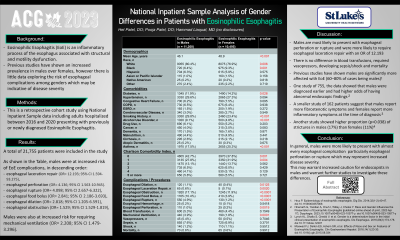Sunday Poster Session
Category: Esophagus
P0417 - National Inpatient Sample Analysis of Gender Differences in Patients With Eosinophilic Esophagitis
Sunday, October 22, 2023
3:30 PM - 7:00 PM PT
Location: Exhibit Hall

Has Audio

Het Patel, DO
St. Luke's University Health Network
Bethlehem, PA
Presenting Author(s)
Het Patel, DO1, Pooja Patel, DO2, Hammad Liaquat, MD2
1St. Luke's University Health Network, Bethlehem, PA; 2St. Luke's University Health Network, Bethlehem, PA
Introduction: Eosinophilic Esophagitis (EoE) is a chronic inflammatory process of the esophagus often associated with structural and motility problems. Previous studies have shown an increased prevalence in males over females, however there is little data exploring the risk of esophageal complications among genders which may be indicative of disease severity.
Methods: This is a retrospective cohort study using National Inpatient Sample data including adults hospitalized between 2016 and 2020 presenting with previously or newly diagnosed Eosinophilic Esophagitis. The primary outcome measured was inpatient complications related to the patient’s history of EoE. Statistical analyses were all performed using STATA software.
Results: Of the 21,755 patients with history of EoE, 17,130 (79%) were white and 11,260 (52%) were males. Of the comorbidities assessed, there was a statically significant relationship (p< 0.05) of smoking and alcohol use in males and relationship of obesity class 3, diabetes, and asthma in females. As shown in the table, males were at increased risk of EoE complications including esophageal obstruction (OR= 1.529; 95% CI 1.529-1.819), requiring esophageal dilation (OR= 2.818; 95% CI 1.205-6.591), requiring esophageal laceration repair (OR= 12.193; 95% CI 1.594-93.275), esophageal food bolus (OR= 2.841; 95% CI 2.186-3.693), esophageal rupture (OR= 4.098; 95% CI 2.657-6.322), and esophageal perforation (OR= 4.136; 95% CI 1.563-10.945). Males were also at increased risk for requiring mechanical ventilation (OR= 2.208; 95% CI 1.479-3.296). There was no statistically significant association (p >0.05) of gender and esophageal hemorrhage, blood transfusions, requiring vasopressors, sepsis, shock, and mortality.
Discussion: In general, males were more likely to present with every esophageal complication except for esophageal hemorrhage which was equivocal. Males are most likely to present with esophageal perforation or rupture and were much more likely to require esophageal laceration repair with an odds ratio of 12.193. Despite male developing more esophageal complications, there is no statistically significant difference in requiring blood transfusions, required vasopressors, developing sepsis, developing shock and mortality between males and females. Our data supports existing literature about the skewed prevalence of EoE and EoE related complications in males using most recently available national inpatient data.
Disclosures:
Het Patel, DO1, Pooja Patel, DO2, Hammad Liaquat, MD2. P0417 - National Inpatient Sample Analysis of Gender Differences in Patients With Eosinophilic Esophagitis, ACG 2023 Annual Scientific Meeting Abstracts. Vancouver, BC, Canada: American College of Gastroenterology.
1St. Luke's University Health Network, Bethlehem, PA; 2St. Luke's University Health Network, Bethlehem, PA
Introduction: Eosinophilic Esophagitis (EoE) is a chronic inflammatory process of the esophagus often associated with structural and motility problems. Previous studies have shown an increased prevalence in males over females, however there is little data exploring the risk of esophageal complications among genders which may be indicative of disease severity.
Methods: This is a retrospective cohort study using National Inpatient Sample data including adults hospitalized between 2016 and 2020 presenting with previously or newly diagnosed Eosinophilic Esophagitis. The primary outcome measured was inpatient complications related to the patient’s history of EoE. Statistical analyses were all performed using STATA software.
Results: Of the 21,755 patients with history of EoE, 17,130 (79%) were white and 11,260 (52%) were males. Of the comorbidities assessed, there was a statically significant relationship (p< 0.05) of smoking and alcohol use in males and relationship of obesity class 3, diabetes, and asthma in females. As shown in the table, males were at increased risk of EoE complications including esophageal obstruction (OR= 1.529; 95% CI 1.529-1.819), requiring esophageal dilation (OR= 2.818; 95% CI 1.205-6.591), requiring esophageal laceration repair (OR= 12.193; 95% CI 1.594-93.275), esophageal food bolus (OR= 2.841; 95% CI 2.186-3.693), esophageal rupture (OR= 4.098; 95% CI 2.657-6.322), and esophageal perforation (OR= 4.136; 95% CI 1.563-10.945). Males were also at increased risk for requiring mechanical ventilation (OR= 2.208; 95% CI 1.479-3.296). There was no statistically significant association (p >0.05) of gender and esophageal hemorrhage, blood transfusions, requiring vasopressors, sepsis, shock, and mortality.
Discussion: In general, males were more likely to present with every esophageal complication except for esophageal hemorrhage which was equivocal. Males are most likely to present with esophageal perforation or rupture and were much more likely to require esophageal laceration repair with an odds ratio of 12.193. Despite male developing more esophageal complications, there is no statistically significant difference in requiring blood transfusions, required vasopressors, developing sepsis, developing shock and mortality between males and females. Our data supports existing literature about the skewed prevalence of EoE and EoE related complications in males using most recently available national inpatient data.
Table: Comparing demographics, comorbidities, Charlson Comorbidity Index, and inpatient complications in males and females with eosinophilic esophagitis.
Abbreviations: COPD = Chronic Obstructive Pulmonary Disease, ESRD = End-Stage Renal Disease
Abbreviations: COPD = Chronic Obstructive Pulmonary Disease, ESRD = End-Stage Renal Disease
Disclosures:
Het Patel indicated no relevant financial relationships.
Pooja Patel indicated no relevant financial relationships.
Hammad Liaquat indicated no relevant financial relationships.
Het Patel, DO1, Pooja Patel, DO2, Hammad Liaquat, MD2. P0417 - National Inpatient Sample Analysis of Gender Differences in Patients With Eosinophilic Esophagitis, ACG 2023 Annual Scientific Meeting Abstracts. Vancouver, BC, Canada: American College of Gastroenterology.
